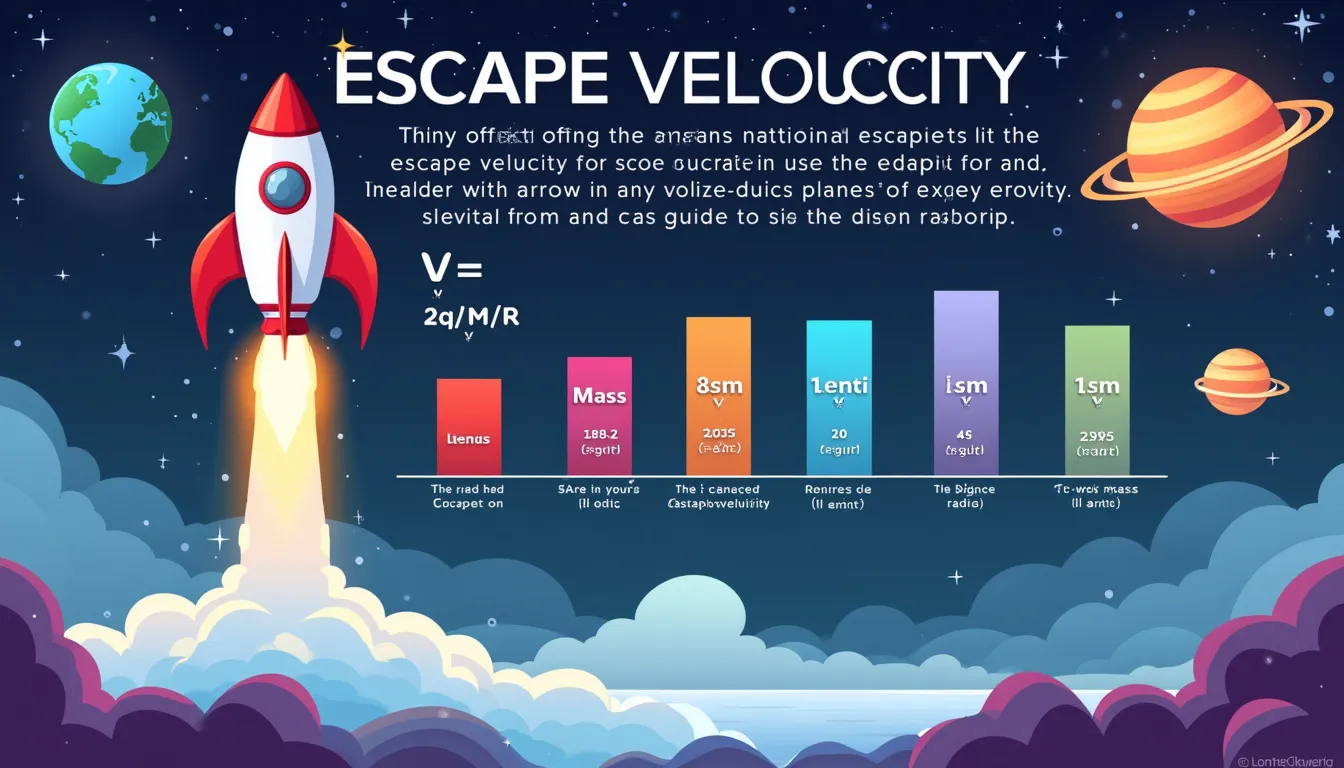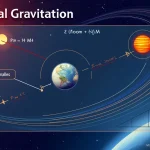Escape Velocity Calculator
Is this tool helpful?
How to Use the Escape Velocity Calculator Effectively
Our Escape Velocity Calculator is a powerful tool designed to help you determine the minimum speed required for an object to break free from a planet’s gravitational pull. To use this calculator effectively, follow these simple steps:
- Enter the gravitational constant of the planet in m³/kg·s². For most calculations, you’ll use the universal gravitational constant of 6.674 × 10⁻¹¹ m³/kg·s².
- Input the mass of the planet in kilograms (kg). For Earth, this value is approximately 5.97 × 10²⁴ kg.
- Provide the radius of the planet in meters (m). Earth’s radius is about 6.37 × 10⁶ m.
- Click the “Calculate” button to obtain the escape velocity in meters per second (m/s).
The calculator will instantly process these inputs and display the escape velocity, giving you valuable insights into the gravitational characteristics of various celestial bodies.
Understanding Escape Velocity: Definition, Purpose, and Benefits
Escape velocity is a fundamental concept in astrophysics and space exploration. It refers to the minimum speed that an object must attain to break free from a planet’s or celestial body’s gravitational field without further propulsion. This critical velocity is essential for launching spacecraft, satellites, and understanding the behavior of objects in space.
The purpose of calculating escape velocity is multifaceted:
- Space Mission Planning: It helps engineers design rockets and spacecraft with sufficient thrust to overcome a planet’s gravity.
- Astronomical Research: Scientists use escape velocity calculations to study the formation and evolution of planetary systems.
- Educational Tool: It serves as an excellent way to teach and understand fundamental principles of physics and astronomy.
- Comparative Planetology: By comparing escape velocities of different planets, we can gain insights into their composition and structure.
The benefits of using our Escape Velocity Calculator include:
- Accuracy: It provides precise calculations based on established physical formulas.
- Time-saving: Eliminates the need for manual calculations, which can be complex and time-consuming.
- Versatility: Can be used for any planet or celestial body, not just Earth.
- Educational Value: Helps students and enthusiasts better understand gravitational concepts.
- Research Aid: Supports scientists and researchers in their studies of planetary physics.
The Science Behind Escape Velocity
The escape velocity is derived from the principle of conservation of energy. When an object is launched from a planet’s surface, it must overcome the planet’s gravitational potential energy. The formula for escape velocity is:
$$v_e = \sqrt{\frac{2GM}{R}}$$
Where:
- v_e is the escape velocity
- G is the gravitational constant
- M is the mass of the planet
- R is the radius of the planet
This equation demonstrates that escape velocity depends on the planet’s mass and radius, making it unique for each celestial body.
How the Escape Velocity Calculator Addresses User Needs
Our Escape Velocity Calculator addresses several key user needs and solves specific problems:
1. Simplified Complex Calculations
Calculating escape velocity manually can be challenging, especially when dealing with large numbers and square roots. Our calculator automates this process, making it accessible to users with varying levels of mathematical expertise.
2. Customizable Inputs
Users can input values for any planet or hypothetical celestial body, allowing for a wide range of applications from real-world scenarios to theoretical physics problems.
3. Instant Results
The calculator provides immediate results, enabling quick comparisons and analyses without the need for time-consuming manual calculations.
4. Educational Support
Students and educators can use this tool to reinforce learning about gravitational physics, planetary science, and space exploration concepts.
5. Research Assistance
Researchers and scientists can utilize the calculator to quickly verify calculations or explore hypothetical scenarios in their studies.
Practical Applications and Use Cases
The Escape Velocity Calculator has numerous practical applications across various fields:
1. Space Mission Planning
Example: NASA engineers use escape velocity calculations to determine the minimum thrust required for a Mars mission spacecraft to leave Earth’s orbit.
2. Astrophysics Research
Use Case: Researchers studying exoplanets can estimate the escape velocity of newly discovered planets to infer information about their atmosphere retention capabilities.
3. Educational Demonstrations
Example: A high school physics teacher uses the calculator to show students how escape velocity differs on various planets in our solar system, enhancing their understanding of gravitational forces.
4. Satellite Deployment
Use Case: Engineers designing communication satellites use the calculator to ensure their launch vehicles can achieve the necessary velocity to place satellites in the correct orbit.
5. Theoretical Physics
Example: A physicist exploring the concept of black holes uses the calculator to demonstrate how escape velocity approaches the speed of light as the mass of an object increases.
Frequently Asked Questions (FAQ)
1. What is escape velocity?
Escape velocity is the minimum speed an object needs to break free from a planet’s gravitational field without further propulsion.
2. How accurate is the Escape Velocity Calculator?
The calculator provides highly accurate results based on the given inputs and the established formula for escape velocity. However, the accuracy depends on the precision of the input values.
3. Can I use this calculator for any planet?
Yes, you can use this calculator for any planet or celestial body as long as you know its mass and radius.
4. Why is the gravitational constant important?
The gravitational constant (G) is a fundamental physical constant that describes the strength of the gravitational force between objects. It’s crucial for accurately calculating escape velocity.
5. How does escape velocity relate to a planet’s atmosphere?
Planets with lower escape velocities tend to have thinner atmospheres because gases can more easily escape into space. Higher escape velocities allow planets to retain denser atmospheres.
6. Can escape velocity change over time?
Yes, a planet’s escape velocity can change if its mass or radius changes. However, these changes are usually minimal over human timescales for most celestial bodies.
7. How does escape velocity differ from orbital velocity?
Escape velocity is the speed needed to leave a planet’s gravitational field entirely, while orbital velocity is the speed required to maintain a stable orbit around the planet.
8. Can I use this calculator for objects other than planets?
Yes, you can use it for any celestial body, including moons, asteroids, or even hypothetical objects, as long as you have the mass and radius data.
9. How does the calculator handle very large or small numbers?
The calculator is designed to handle scientific notation, making it suitable for the extreme scales often encountered in astronomical calculations.
10. Is the calculator’s result affected by an object’s mass?
No, the escape velocity is independent of the mass of the escaping object. It only depends on the mass and radius of the planet or celestial body being escaped from.
Conclusion: Harness the Power of Escape Velocity Calculations
Our Escape Velocity Calculator is an invaluable tool for anyone interested in space science, astrophysics, or planetary exploration. By providing quick and accurate calculations, it empowers users to:
- Gain deeper insights into planetary physics
- Support space mission planning and research
- Enhance educational experiences in physics and astronomy
- Explore hypothetical scenarios in theoretical physics
- Compare gravitational characteristics of different celestial bodies
Whether you’re a student, educator, researcher, or space enthusiast, this calculator offers a user-friendly way to engage with complex gravitational concepts. It bridges the gap between theoretical knowledge and practical application, making the wonders of space science more accessible to all.
We encourage you to explore the Escape Velocity Calculator and discover the fascinating world of planetary physics. Use it to fuel your curiosity, support your studies, or advance your research. The mysteries of the universe are at your fingertips – start calculating and unlock the secrets of planetary escape today!
Remember, every great space journey begins with understanding the fundamental forces that govern our universe. Let the Escape Velocity Calculator be your first step towards the stars!
Important Disclaimer
The calculations, results, and content provided by our tools are not guaranteed to be accurate, complete, or reliable. Users are responsible for verifying and interpreting the results. Our content and tools may contain errors, biases, or inconsistencies. We reserve the right to save inputs and outputs from our tools for the purposes of error debugging, bias identification, and performance improvement. External companies providing AI models used in our tools may also save and process data in accordance with their own policies. By using our tools, you consent to this data collection and processing. We reserve the right to limit the usage of our tools based on current usability factors. By using our tools, you acknowledge that you have read, understood, and agreed to this disclaimer. You accept the inherent risks and limitations associated with the use of our tools and services.







